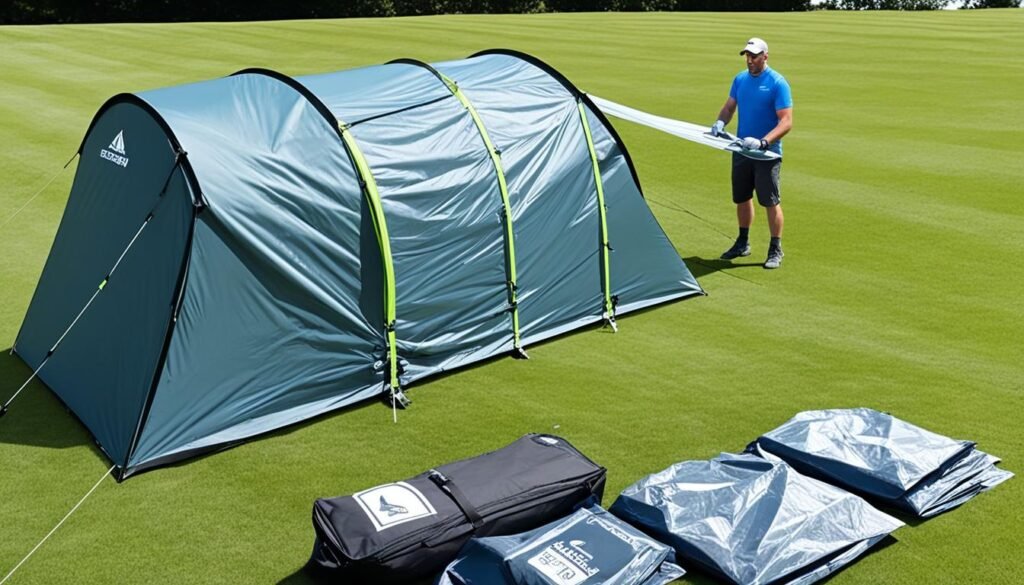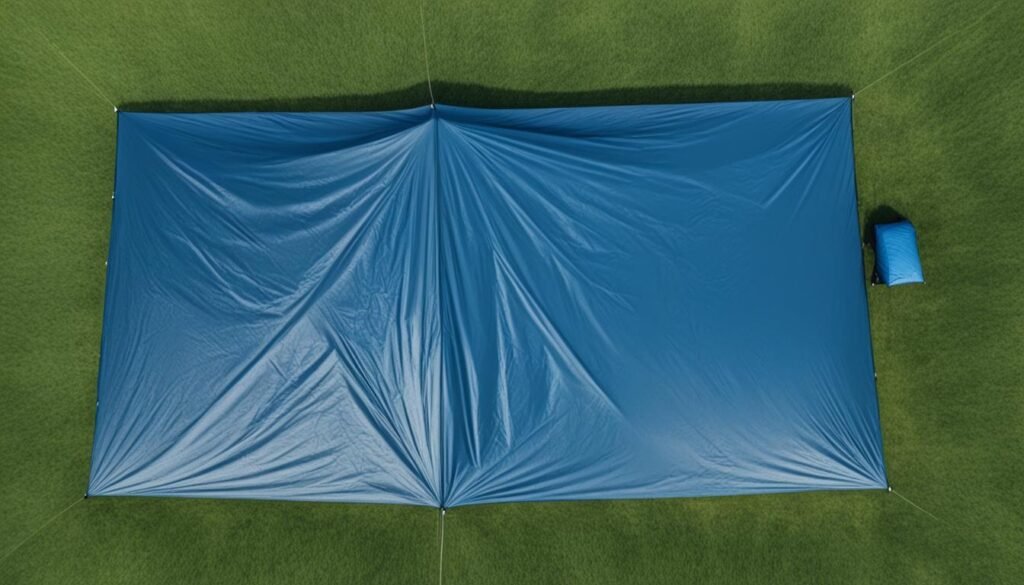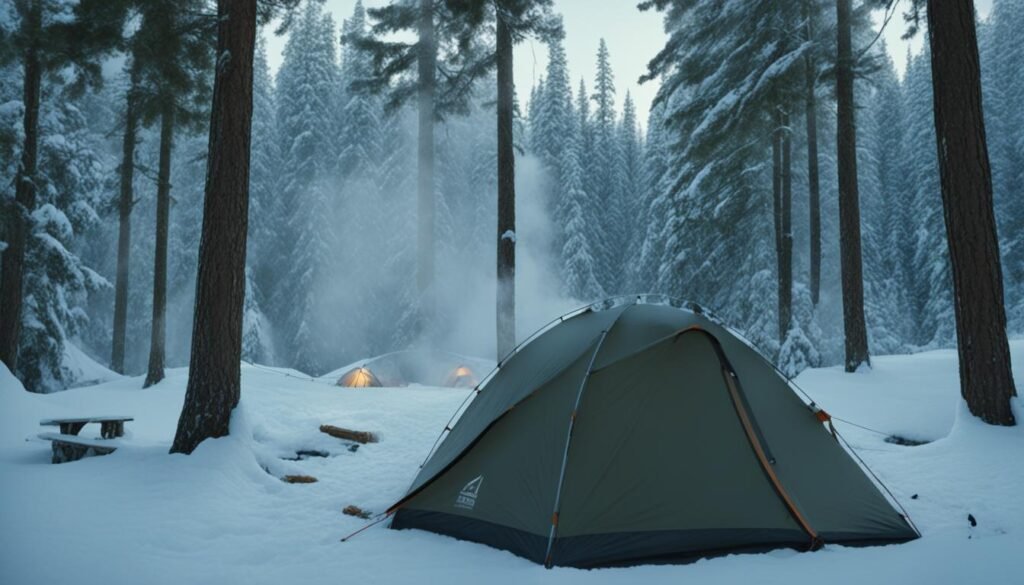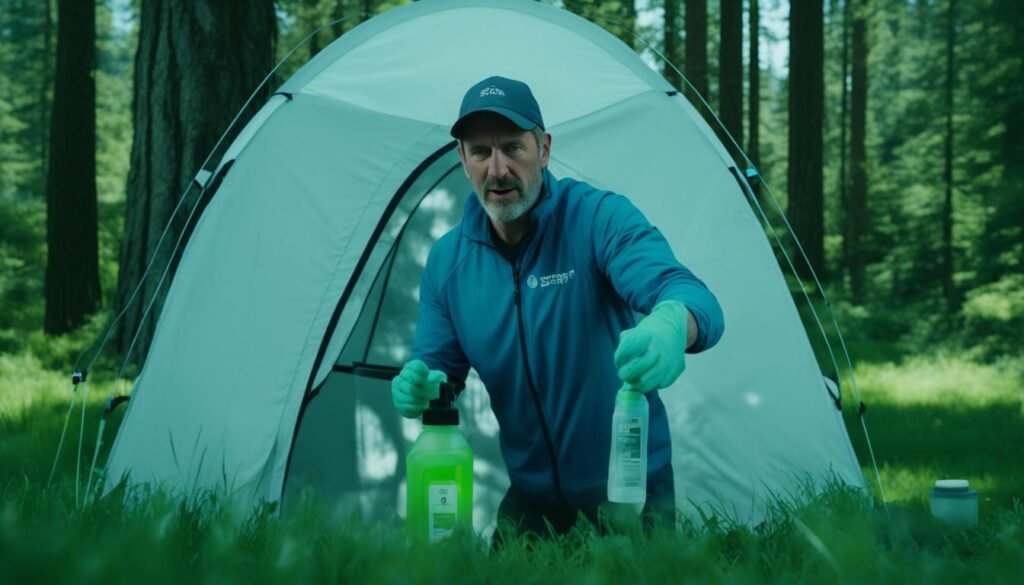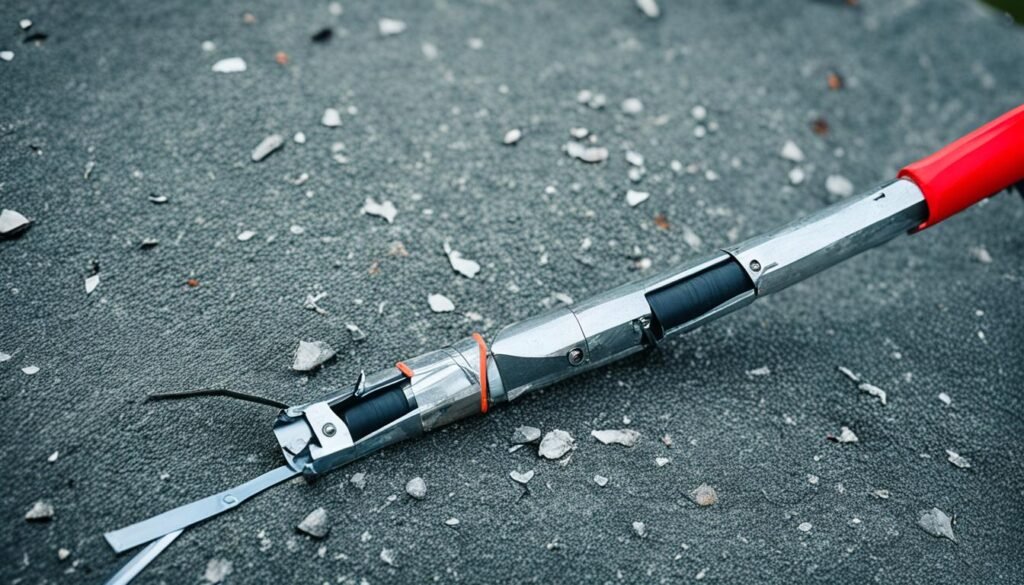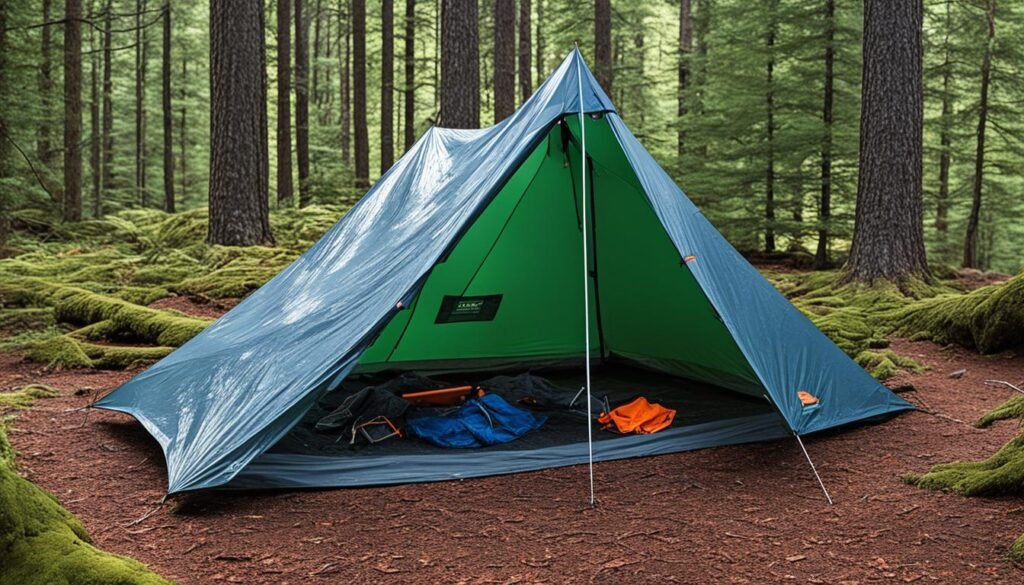Proper storage of your tent is essential to ensure its longevity and prevent issues such as mildew growth and material breakdown. After an exciting camping trip, it’s crucial to know how to store your tent correctly to keep it in excellent condition for future adventures.
In this article, I will guide you on the best practices for tent storage, including how to properly dry your tent, store it in a cool, dry place, and conduct regular maintenance. By following these steps, you can extend the lifespan of your tent and avoid costly repairs or replacements.
Key Takeaways:
- Ensure your tent is completely dry before storing to prevent mold and mildew growth.
- Store your tent loosely in a cool, dry place to relax the fabrics and reduce tension.
- Regularly inspect your tent for damage and address any repairs promptly.
- Properly fold or roll your tent to preserve its shape and make it easier to pitch next time.
- Store tent pegs and poles separately in designated bags to protect the tent fabrics.
Step 1: Dry Your Tent
Properly drying your tent is crucial to prevent mildew growth and maintain the cleanliness of the fabric. Dampness can lead to damage in the form of mold, mildew, and deteriorated waterproof coatings. Follow these steps to ensure your tent is completely dry before storing it:
- Set up your tent indoors or in a shaded outdoor spot.
- Allow the tent to air dry naturally, taking advantage of airflow and sunlight if possible.
- If there are any dirt or stain marks, clean them using cold water and mild soap.
- Rinse the tent thoroughly to remove any soap residue.
Remember, it is essential to ensure your tent is completely dry before packing it away. Any moisture left in the fabric can lead to unpleasant odors, structural damage, and a higher risk of mildew growth. Take the time to properly dry your tent to maintain its longevity and prevent potential issues in the future.
Here is an image showcasing the importance of dry tents in preventing mildew growth:
Properly drying your tent is the first step towards storing it correctly and keeping it in excellent condition for future adventures. Now that your tent is dry, let’s move on to the next step: storing your tent loosely in a cool, dry place.
Step 2: Store Your Tent Loosely in a Cool, Dry Place
When it comes to storing your tent, it’s important to avoid using the compact stuff sack that came with it. Long-term storage in a tightly packed bag can compress the tent fabrics and create unnecessary tension, leading to potential damage.
Instead, opt for a more relaxed storage method that allows the tent fabrics to breathe and unwind. Consider using an old pillowcase or a mesh bag to store your tent loosely.
By providing ample space for the tent to expand and contract naturally, you reduce the risk of fabric stress and extend its lifespan. Remember, a relaxed tent is a happy tent!
When it comes to tent poles, they should be stored in a way that distributes tension evenly along the cord. Consider storing them partially assembled or collapsing them starting from the middle. This method helps minimize the strain on the poles and ensures they stay in good condition.
Now that you know the proper technique for storing your tent, it’s essential to choose the right location. Opt for a cool, dry spot in your home, such as a gear closet or garage. This environment helps prevent moisture buildup, mildew growth, and other potential damage.
Benefits of Storing Your Tent Properly:
“Properly storing your tent helps relax the fabrics and reduce tension, prolonging its lifespan.”
Follow these easy steps to store your tent correctly, and you’ll have peace of mind knowing it’s in good condition and ready for your next adventure.
| Benefits of Proper Tent Storage: | How to Achieve It: |
|---|---|
| Reduced fabric stress and tension | Store tent loosely in a pillowcase or mesh bag |
| Prevention of mold and mildew growth | Choose a cool, dry storage location |
| Extended lifespan of tent materials | Store poles partially assembled or collapsed from the middle |
Storing your tent properly not only protects your investment but also ensures that it remains in optimal condition for future camping trips. Remember, a little extra care and attention go a long way in preserving the quality and longevity of your tent.
Why Proper Tent Storage is Important
Proper tent storage is of utmost importance to safeguard your investment and ensure its longevity. The way you store your tent can greatly impact its condition and performance for future camping trips. Failing to store your tent correctly can result in a range of issues, including broken poles, ripped fabric, mold and mildew growth, and compromised waterproofing.
When you consider the time and money you’ve invested in your tent, it’s crucial to take the necessary steps to protect it during storage. By following the recommended storage guidelines, you can prevent potential damage and extend the lifespan of your tent.
The Consequences of Improper Tent Storage
Poor tent storage practices can have serious consequences, leading to significant damage and the need for costly repairs or replacements. Here are some potential outcomes of improper tent storage:
- Broken Poles: Improper storage can result in bent or broken tent poles, rendering your tent unusable until they are replaced.
- Ripped Fabric: Storing your tent in a compact and tightly packed manner can cause stress on the fabric, leading to tears and weakened material.
- Mold and Mildew Growth: Failing to fully dry your tent before storage can create a damp environment, providing a breeding ground for mold and mildew. This can cause unpleasant odors and compromise the integrity of the fabric.
- Loss of Waterproofing: Incorrect storage can damage the waterproof coatings of your tent, resulting in decreased resistance to water and potential leaks during future camping trips.
To avoid these consequences and protect your tent, it’s essential to store it properly, following the recommended guidelines.
Proper Tent Storage Guidelines
Follow these guidelines to ensure your tent remains in excellent condition during storage:
- Thoroughly Clean and Dry Your Tent: Before storing your tent, make sure it is completely clean and dry to prevent the growth of mold and mildew. Gently clean any dirt or stains with cold water and mild soap, rinsing well afterward. Set up your tent indoors or in a shaded outdoor spot to allow it to air dry fully.
- Store Your Tent Loosely: Avoid using the compact stuff sack that may have come with your tent. Instead, use a larger storage bag, such as an old pillowcase or mesh bag. Store your tent loosely to allow the fabrics to relax and breathe, preventing unnecessary tension and stress.
- Choose a Cool, Dry Storage Location: Opt for a cool and dry spot in your home, such as a gear closet or garage, to store your tent. Avoid locations that are prone to extreme temperatures or humidity, as they can accelerate fabric deterioration and mold growth.
By following these guidelines, you can ensure that your tent remains in optimal condition, ready for your next camping adventure.
Image: Tent storage is crucial for preventing damage and ensuring the longevity of your tent.
The Consequences of Improper Tent Storage
Improper storage of your tent can have significant consequences, resulting in potential damage and reduced lifespan. It is essential to understand the risks associated with improper tent storage to ensure the longevity and performance of your camping gear.
Mold and Mildew Growth
Storing a tent when damp or wet can create a breeding ground for mold and mildew. These fungal growths can lead to unpleasant odors, stains, and weakened fabric. Over time, mold and mildew can cause structural damage that is difficult to repair.
Improper storage of a wet tent can lead to mold and mildew growth, which not only affects the tent’s integrity but also poses potential health risks.
Compression and Fabric Strain
Using a small stuff sack to store your tent can result in excessive compression and strain on the tent’s fabrics. This can lead to tears, fraying, and weakened waterproofing. It is important to allow the tent to breathe and maintain its natural shape during storage.
Material Breakdown
Storing a tent in damp or hot environments can expedite material breakdown. Heat and moisture can cause the tent’s fabrics to deteriorate, compromising their strength and ability to withstand the elements. It is crucial to store your tent in a cool, dry place to help preserve its quality over time.
Proper tent storage is key to minimizing the risk of these consequences and keeping your camping gear in optimal condition for future adventures.
| Consequence | Effect |
|---|---|
| Mold and Mildew Growth | Unpleasant odors, stains, weakened fabric, and potential health risks |
| Compression and Fabric Strain | Tears, fraying, weakened waterproofing |
| Material Breakdown | Deterioration of fabric quality and integrity |
Importance of Drying Your Tent
When it comes to proper tent storage, drying your tent is of utmost importance. Failure to completely dry your tent before storing it can have detrimental effects, including the growth of mold and mildew. Moisture trapped in the fabric can lead to unpleasant odors, discoloration, and even structural damage over time.
Properly drying your tent after each use ensures that it remains fresh, clean, and ready for your next camping adventure. By following these simple steps, you can prevent mold growth and preserve the longevity of your tent:
- Gently shake off any loose dirt or debris from the tent.
- Set up your tent in a well-ventilated area, preferably in a shaded spot.
- Remove the rainfly, if applicable, and allow both the inner tent and rainfly to air dry separately.
- If there are any visible stains, clean them using a mild soap and cold water, then rinse thoroughly.
- Ensure that all parts of the tent, including the floor, walls, and seams, are completely dry before packing it away.
Drying your tent properly not only prevents mold and mildew growth but also helps maintain the integrity of the fabric, keeping it in excellent condition for years to come.
“Proper drying ensures that your tent remains fresh, clean, and ready for future camping adventures.”
Remember, the key to preventing mold and mildew is allowing your tent to dry thoroughly before storing it. Take the time to properly dry your tent, and it will reward you with many more enjoyable camping experiences.
| Benefits of Drying Your Tent: |
|---|
| Prevents mold and mildew growth |
| Eliminates unpleasant odors caused by moisture |
| Preserves the integrity of the tent fabric |
| Extends the lifespan of your tent |
Checking for Damage Before Storage
Inspecting your tent for any damage before storing it is an essential step to ensure its longevity and usability. By addressing any issues upfront, you can repair or replace damaged parts before your next camping trip. Properly inspecting your tent includes checking for the following:
- Rips or tears in the tent fabric.
- Broken or bent poles.
- Defective zippers or closures.
- Worn or frayed stitching.
Thoroughly examine your tent both on the inside and outside to identify any signs of damage. Minor issues like small tears can often be easily repaired using tent repair kits available in outdoor stores. However, if you notice significant damage or if you’re uncertain about the extent of the problem, it’s best to seek professional assistance or contact the tent manufacturer for advice.
Addressing any damage before storage ensures that your tent is in good condition and ready for your next camping adventure. Neglecting to inspect and repair your tent can lead to further damage, rendering the tent unusable and requiring costly repairs or replacements.
“Regularly inspecting your tent for damage is crucial for maintaining its functionality and performance. It’s better to identify and address issues early on rather than discovering them right before your next camping trip.”
Below is a table summarizing common tent damage to look out for and appropriate actions to take:
| Tent Damage | Action |
|---|---|
| Rips or tears in the fabric | Repair with tent repair kit or patch |
| Broken or bent poles | Replace damaged poles |
| Defective zippers or closures | Repair or replace zippers |
| Worn or frayed stitching | Restitch or reinforce seams |
Regularly checking your tent for damage and promptly addressing any issues will help extend its lifespan and ensure many enjoyable camping experiences in the future.
Proper Technique for Folding or Rolling Your Tent
When it comes to storing your tent, folding or rolling it properly is key to preserving its shape and ensuring easy setup on your next camping trip. Avoid the temptation to forcefully squash the tent into its bag, as this can damage both the tent and the bag itself. Instead, follow the recommended folding or rolling technique provided in the tent’s instructions.
Each tent is unique, and the manufacturer’s instructions will guide you on the best way to fold or roll your specific tent model. It’s important to pay attention to these guidelines to avoid unnecessary wear and tear on the tent fabric and components. Taking the time to store your tent correctly will save you time and frustration when it’s time to pitch it again.
Remember, properly folding or rolling your tent not only helps preserve its shape but also keeps it in good condition, ensuring a longer lifespan and many more adventures to come.
Folding Technique
To fold your tent, start by removing any tent stakes or pegs and setting them aside. Lay the tent flat on the ground, smoothing out any wrinkles or creases. Begin folding the tent in thirds or quarters, depending on its size, starting from one end to the other.
Once the tent is neatly folded into a manageable size, carefully place it into the storage bag or any alternative storage container you intend to use. Be gentle when compressing it to avoid unnecessary strain on the tent fabric and poles. Remember to store any remaining tent accessories, such as rainfly or footprint, separately to prevent any potential damage.
Rolling Technique
If rolling your tent is the preferred method, start by removing the tent stakes or pegs. Lay the tent flat on the ground and smooth out any wrinkles. Start rolling the tent tightly from one end to the other, ensuring it remains as compact as possible without causing stress to the fabric or poles. As you roll, remove any trapped air and make any necessary adjustments to keep the roll firm and secure.
Once the tent is rolled, carefully place it into your storage bag or container. Avoid overstuffing or forcing the tent into the bag, as this can strain the fabric and compromise its shape. Use gentle yet firm pressure to secure the rolled tent, making sure it fits comfortably within the storage space.
Bagging and Storing Tent Pegs and Poles
To protect your tent during storage, it is important to store the tent pegs and poles properly. Most tents come with separate bags for these components. Ensure that you store all sharp objects, such as pegs and poles, in their designated bags to prevent them from damaging the tent fabrics.
If you don’t have the original bags, use alternative methods to wrap them up and protect your tent.
Alternative Storage Methods
If you no longer have the original bags for your tent pegs and poles, you can try these alternative storage methods:
- Use a small cloth bag or drawstring pouch to keep the pegs and poles together.
- Wrap each peg in a soft cloth or bubble wrap before placing them in a larger bag.
- For tent poles, consider using a padded bag or wrapping them individually in foam pipe insulation.
Remember, the goal is to prevent any sharp edges or points from coming into contact with the tent fabric, leading to tears or punctures. Taking a few extra minutes to store your tent pegs and poles properly will help protect your tent and ensure it stays in great condition for your next camping adventure.
Tips for Tent Care and Maintenance
Proper care and maintenance of your tent are essential for prolonging its lifespan. By following these tent care instructions and maintenance tips, you can ensure that your tent remains in excellent condition for many camping trips to come.
Air Out Your Tent Before Folding
After each camping trip, it’s important to give your tent some time to air out before folding it up for storage. This allows any trapped moisture or odors to dissipate, preventing mold and mildew growth. Simply set up your tent in a well-ventilated area, such as your backyard, and let it air out for a few hours.
Sweep and Clean the Interior
Before packing away your tent, make sure to clean the interior to remove any dirt, debris, or food particles that may have accumulated. Use a soft brush or broom to gently sweep out the tent, paying special attention to the corners and crevices. If needed, you can wipe down the interior with a damp cloth or sponge and mild soap. Remember to rinse well and allow the tent to dry completely before packing it up.
Partially Zip the Doors for Air Circulation
When storing your tent, it’s beneficial to partially zip the doors to allow air circulation. This helps prevent stagnant air from causing moisture buildup inside the tent, which can lead to mold and mildew. Keep the doors zipped just enough to allow for airflow, but not wide open to avoid dust or insects entering the tent.
Use Duct Tape for Minor Repairs
If you notice any small tears or punctures in your tent fabric, you can quickly fix them using duct tape. Cut a piece of duct tape to cover the damaged area, ensuring that it extends beyond the edges for a secure seal. This temporary repair will prevent further damage and keep your tent watertight until you can properly mend it.
Use a Removable Groundsheet
To protect the bottom of your tent from sharp rocks, twigs, and other potential hazards, consider using a removable groundsheet. This additional layer adds an extra barrier of protection and is easier to clean or replace if it becomes damaged. It also helps to extend the lifespan of your tent by reducing wear and tear on the tent floor.
Apply Seam Sealant
To enhance your tent’s performance and durability, consider applying seam sealant to the seams. Seam sealant creates a waterproof barrier and helps prevent water from seeping through the stitch holes. Follow the instructions provided with the sealant and ensure that the tent is clean and dry before application.
| Tent Care and Maintenance Tips |
|---|
| Air out your tent before folding |
| Sweep and clean the interior |
| Partially zip the doors for air circulation |
| Use duct tape for minor repairs |
| Use a removable groundsheet |
| Apply seam sealant |

Follow these tent care instructions and maintenance tips to keep your tent in top-notch condition. By taking good care of your tent, you can ensure its longevity and enjoy countless memorable camping experiences.
How to Keep Your Tent Forever
By following proper care, maintenance, and storage practices, you can help ensure that your tent lasts for many years. Cleaning your tent regularly, repairing any damage promptly, and storing it correctly will contribute to preserving its lifespan and keeping it in excellent condition. Taking these steps will save you money in the long run and ensure that you can continue enjoying outdoor adventures with your trusty tent.
Regular Cleaning for Longevity
Keeping your tent clean is essential for maintaining its durability and longevity. Regularly remove dirt, debris, and stains from both the interior and exterior. Use mild soap and cold water to gently clean the tent fabric, and make sure to rinse it thoroughly and allow it to dry completely before storing.
Prompt Repairs for Optimal Performance
Addressing any damage or wear and tear promptly is crucial for preserving the lifespan of your tent. Inspect your tent for any signs of rips, tears, or broken poles before and after each camping trip. Utilize a tent repair kit to fix minor issues, and consider seeking professional assistance for more extensive repairs.
Proper Storage Techniques for Protection
The way you store your tent can significantly impact its lifespan. Avoid compressing your tent into a stuff sack for long-term storage, as this can strain the fabrics and compromise its integrity. Instead, opt for storing the tent loosely in a cool, dry place, such as a gear closet or garage. Utilize an old pillowcase or mesh bag to protect the tent while allowing air circulation.
Regular Inspections for Timely Maintenance
Regularly inspect your tent for any signs of damage, even when it’s not in use. Look for issues such as fraying seams, weakened zippers, or bent poles. By catching and addressing these problems early on, you can prevent further damage and extend your tent’s lifespan.
Protection from Harsh Elements
While tents are designed to withstand various weather conditions, it’s essential to protect them from extreme elements whenever possible. Avoid pitching your tent under direct sunlight for extended periods, as this can weaken the fabric and materials. Additionally, store your tent away from damp areas to prevent mildew or mold growth.
Proper Use and Care
Lastly, remember to use your tent according to its intended purpose and follow all care instructions provided by the manufacturer. Avoid placing excessive weight on the tent, be gentle when handling zippers and poles, and never leave it pitched for an extended period without proper ventilation. Proper use and care will help maintain your tent’s integrity for years to come.
The Consequences of Improper Tent Care
Neglecting proper tent care can have severe consequences for your tent’s performance and longevity. Failure to clean your tent and address damage promptly can result in mold, mildew, weakened fabric, and compromised waterproofing. Over time, the tent may become unusable, requiring costly repairs or replacement. Taking the time to care for your tent will help you avoid these issues and prolong its lifespan.
Without regular care and maintenance, your tent is vulnerable to various problems that can impact its functionality and durability. Neglecting proper tent care can lead to:
| Consequences of Neglecting Tent Care | Description |
|---|---|
| Mold and Mildew Growth | Moisture trapped in an uncared for tent can create the perfect environment for mold and mildew to thrive. This can lead to unpleasant smells, discoloration, and potential health hazards. |
| Weakened Fabric | Failing to clean and care for your tent can result in fabric deterioration, making it more prone to tears and holes. This compromises the structural integrity of the tent and reduces its lifespan. |
| Compromised Waterproofing | Over time, neglecting tent care can cause the waterproofing properties to degrade. This means that even if the tent was originally waterproof, it may lose its ability to repel water, leading to leaks and an uncomfortable camping experience. |
| Costly Repairs or Replacement | If tent care is consistently neglected, the accumulated damage can reach a point where repairs are no longer feasible, and a replacement becomes necessary. This can be a costly expenditure that could have been prevented with proper care. |
Regular tent care is essential for maintaining your tent’s performance and prolonging its lifespan. By taking the time to clean your tent, address damage promptly, and store it correctly, you can avoid the consequences outlined above and ensure that your tent remains in excellent condition for many camping trips to come.
The Importance of Regular Tent Maintenance
Regular tent maintenance is crucial for keeping your tent in good condition and ready for use. By inspecting for damage, cleaning, and addressing any repairs or maintenance needs, you can ensure that your tent is always in top shape. This will enhance your outdoor experience by providing a reliable and comfortable shelter.
Inspecting your tent regularly allows you to identify any issues that may affect its performance. Look for signs of wear, such as tears, rips, or broken poles. Addressing these problems promptly will prevent further damage and ensure the longevity of your tent.
Cleaning your tent after each use is essential for maintaining its durability and functionality. Use a mild soap, cold water, and a sponge or soft brush to remove dirt or stains. Rinse thoroughly and allow your tent to air dry completely before storing it. Regular cleaning prevents the buildup of debris and extends the lifespan of your tent.
“Regular tent maintenance is like taking care of a reliable friend. It ensures that your tent is always ready to provide shelter and comfort during your outdoor adventures.”
In addition to inspections and cleaning, addressing any necessary repairs or maintenance is vital for keeping your tent in good condition. Replace broken poles, patch up tears or holes, and fix any damaged zippers or seams. Ignoring these issues can lead to further damage and compromise the integrity of your tent.
Benefits of Regular Tent Maintenance
Engaging in regular tent maintenance offers several benefits:
- Maximizes the lifespan of your tent
- Ensures structural stability
- Preserves the waterproofing capabilities
- Prevents the growth of mold or mildew
- Provides a clean and comfortable camping experience
Investing time in the proper care and maintenance of your tent will pay off in the long run. Your tent will remain reliable and durable, ready to accompany you on many more outdoor adventures.
Final Thoughts
Maintaining your tent through regular inspections, cleaning, and repairs is essential for ensuring its longevity and peak performance. By taking the time to care for your tent, you can keep it in excellent condition and ready for your next camping trip. Remember, a well-maintained tent is a reliable outdoor companion.
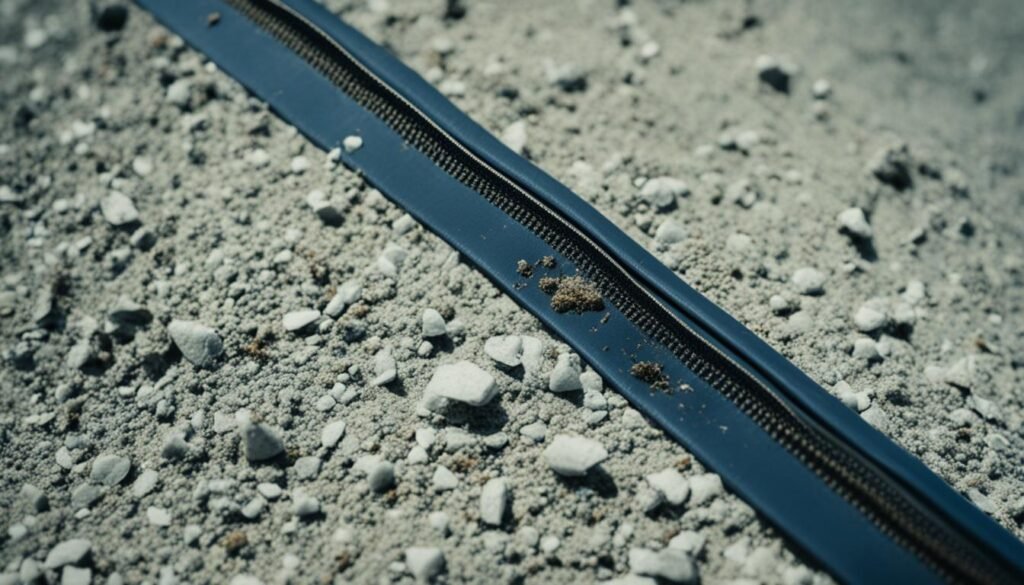
The Significance of Proper Tent Storage Techniques
Using proper tent storage techniques is vital for extending the lifespan of your tent and avoiding costly damage. Storing a tent when damp or in extreme temperatures can lead to mold, mildew, fabric deterioration, and compromised waterproofing. By following the recommended storage guidelines, you can preserve your tent’s quality and usability for years to come.
When it comes to tent storage, there are a few key principles to keep in mind. Dryness is paramount. Moisture left in the fabric can cause mold and mildew growth, leading to unpleasant odors, discoloration, and ultimately, structural damage. It’s essential to ensure that your tent is completely dry before packing it away.
Choosing the right storage location is also crucial. Extreme temperatures, whether hot or cold, can weaken the tent’s fabrics and coatings over time. Opt for a cool, dry place, such as a gear closet or garage, to protect your tent from potential damage.
Additionally, the way you pack and store your tent plays a significant role in its longevity. Avoid tightly compressing the tent into a stuff sack, as this can strain the fabrics and compromise their integrity. Instead, use a larger storage bag or an old pillowcase that allows the tent to breathe and relax.
Properly storing your tent’s poles and pegs is equally important. Make sure to store them in their designated bags or find alternative methods to protect them from damaging the tent fabrics. Keeping all the components organized ensures easier setup and prolongs the life of your tent.
Why Proper Tent Storage Matters:
- Prevents mold and mildew growth
- Preserves fabric quality and waterproofing
- Reduces the risk of structural damage
- Extends the lifespan of your tent
- Avoids costly repairs or replacements
Remember, spending a little extra time and effort on proper tent storage techniques can go a long way in preserving your tent’s quality and usability. Take care of your tent, and it will continue to serve as a reliable shelter for your outdoor adventures.
Conclusion
Proper tent storage is crucial for maintaining the condition and longevity of your tent. By following these tent storage tips and packing your tent after camping, you can ensure that it stays in excellent shape for future camping adventures.
First, make sure to thoroughly dry your tent before storing it. This will prevent mildew growth and keep the fabric in good condition. Set up your tent indoors or in a shaded outdoor spot and clean any dirt or stains with cold water and mild soap.
Next, store your tent loosely in a cool, dry place. Avoid using the compact stuff sack and instead opt for an old pillowcase or mesh bag that allows the fabrics to relax and breathe. Partially assemble or collapse your tent poles to distribute tension along the cord.
By taking the time to care for your tent and store it properly, you can extend its lifespan and avoid costly damage. Remember to conduct regular maintenance, inspect for damage, and address any repairs promptly. With these tent storage tips in mind, you can enjoy many more outdoor adventures with your trusty tent.
FAQ
How should I store my tent after camping?
To store your tent correctly, ensure it is completely dry before storing and store it loosely in a cool, dry place.
Why is it important to dry my tent before storage?
Drying your tent before storage is crucial to prevent mold and mildew growth, which can lead to unpleasant odors and structural damage.
Should I use the compact stuff sack for long-term storage?
No, it is best to avoid using the compact stuff sack that came with your tent for long-term storage. Instead, use an old pillowcase or mesh bag to store your tent loosely and allow the fabrics to relax and breathe.
How should I store my tent poles?
Store your tent poles partially assembled or collapse them starting from the middle to distribute tension along the cord.
Where is the best place to store my tent?
Choose a dry, cool spot in your home, such as a gear closet or garage, for storing your tent.
What are the consequences of improper tent storage?
Improper storage can lead to broken poles, ripped fabric, mildew growth, and loss of waterproofing.
What are the consequences of neglecting proper tent care?
Neglecting proper tent care can result in mold, mildew, weakened fabric, compromised waterproofing, and the need for costly repairs or replacement.
How can I preserve the shape of my tent during storage?
Fold or roll your tent properly following the recommended technique provided in the tent’s instructions, avoiding forcefully squashing it into its bag.
How should I store tent pegs and poles?
Store tent pegs and poles separately in their designated bags to prevent them from damaging the tent fabrics. If you don’t have the original bags, use alternative methods to wrap them up and protect your tent.
What are some tips for tent care and maintenance?
Some tips include airing out the tent before folding, sweeping and cleaning the interior, partially zipping the doors for air circulation, and using duct tape for minor repairs. Additional maintenance steps include using a removable groundsheet and applying seam sealant.
How can I keep my tent in good condition for a long time?
By following proper care, maintenance, and storage practices, you can prolong the lifespan of your tent. Regular cleaning, prompt repairs, and correct storage will contribute to the tent’s performance, durability, and your overall enjoyment of outdoor adventures.
What are the consequences of improper tent care?
Improper tent care can result in mold, mildew, weakened fabric, compromised waterproofing, and the need for costly repairs or replacement.
Why is regular tent maintenance important?
Regular maintenance is crucial for keeping your tent in good condition and ready for use. Inspecting for damage, cleaning, and addressing repairs or maintenance needs enhance the tent’s performance, durability, and your overall outdoor experience.
What is the significance of proper tent storage techniques?
Proper tent storage techniques are essential for extending the lifespan of your tent and avoiding costly damage. By following the recommended storage guidelines, you can preserve your tent’s quality and usability for years to come.
How should I pack away my tent after camping?
To pack away your tent after camping, ensure it is completely dry, fold or roll it properly to preserve its shape, and store it loosely in a cool, dry place.

